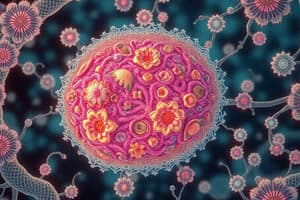Podcast
Questions and Answers
What is the primary organization of genetic material in eukaryotic cells?
What is the primary organization of genetic material in eukaryotic cells?
- Chromosomes (correct)
- Plasmids
- Single DNA molecule
- RNA strands
Which of the following is NOT a main part of eukaryotic cells?
Which of the following is NOT a main part of eukaryotic cells?
- Golgi apparatus
- Chloroplasts (correct)
- Ribosomes
- Mitochondria
How do eukaryotic cells compare to prokaryotic cells in terms of complexity?
How do eukaryotic cells compare to prokaryotic cells in terms of complexity?
- Eukaryotic cells have no complexity.
- Eukaryotic cells are simpler and smaller.
- Eukaryotic cells are larger and more complex. (correct)
- Eukaryotic cells are the same size and complexity.
Which of the following organisms is classified as a eukaryote?
Which of the following organisms is classified as a eukaryote?
What is the function of the Golgi apparatus in eukaryotic cells?
What is the function of the Golgi apparatus in eukaryotic cells?
What is the primary component of plant cell walls?
What is the primary component of plant cell walls?
Which substance is found in the cell walls of fungi?
Which substance is found in the cell walls of fungi?
What differentiates the cell walls of plant cells from those of bacteria?
What differentiates the cell walls of plant cells from those of bacteria?
Which of the following statements is true regarding cell walls?
Which of the following statements is true regarding cell walls?
Which material is unique to bacterial cell walls?
Which material is unique to bacterial cell walls?
What structure is present in plant cells but not in animal cells?
What structure is present in plant cells but not in animal cells?
Which organelle is responsible for photosynthesis in plant cells?
Which organelle is responsible for photosynthesis in plant cells?
Which of the following statements correctly differentiates plant cells from animal cells?
Which of the following statements correctly differentiates plant cells from animal cells?
What is the primary function of the cell wall in plant cells?
What is the primary function of the cell wall in plant cells?
Which of the following best defines a plant cell?
Which of the following best defines a plant cell?
What is a common misconception about the cell wall in plant cells?
What is a common misconception about the cell wall in plant cells?
Which statement accurately reflects the role of the cell wall in plants?
Which statement accurately reflects the role of the cell wall in plants?
Why is it incorrect to view the cell wall as merely mechanical?
Why is it incorrect to view the cell wall as merely mechanical?
Which of the following is NOT a function of the cell wall?
Which of the following is NOT a function of the cell wall?
What is the primary characteristic that distinguishes plant cells from most other cells?
What is the primary characteristic that distinguishes plant cells from most other cells?
In what way does the perception of the cell wall being inactive affect the understanding of plant biology?
In what way does the perception of the cell wall being inactive affect the understanding of plant biology?
In which of the following organisms are chloroplasts primarily found?
In which of the following organisms are chloroplasts primarily found?
Why are chloroplasts significant in plant cells?
Why are chloroplasts significant in plant cells?
Which statement about chloroplasts is incorrect?
Which statement about chloroplasts is incorrect?
Chloroplasts give plants their green color primarily due to which pigment?
Chloroplasts give plants their green color primarily due to which pigment?
Flashcards are hidden until you start studying
Study Notes
Eukaryotic Cells
- Examples include plants, animals, protists, and fungi.
- Genetic material organized in chromosomes.
- Larger and more complex than prokaryotic cells.
Main Parts of Eukaryotic Cells
- Nucleus: Control center containing genetic material.
- Golgi Apparatus: Involved in modifying, sorting, and packaging proteins.
- Mitochondria: Powerhouse of the cell, producing energy through respiration.
- Ribosomes: Sites of protein synthesis.
Differences Between Plant and Animal Cells
- Cell Wall: Present in plant cells, providing structure and support; absent in animal cells.
- Chloroplasts: Found in plant cells for photosynthesis; typically absent in animal cells.
Plant Cell Characteristics
- Basic unit of all plants, crucial for life processes.
- Cell walls composed of cellulose, distinguishing them from bacterial (peptidoglycan) and fungal (chitin) cell walls.
- Chloroplasts enable photosynthesis, allowing plants to convert light energy into chemical energy.
Studying That Suits You
Use AI to generate personalized quizzes and flashcards to suit your learning preferences.




